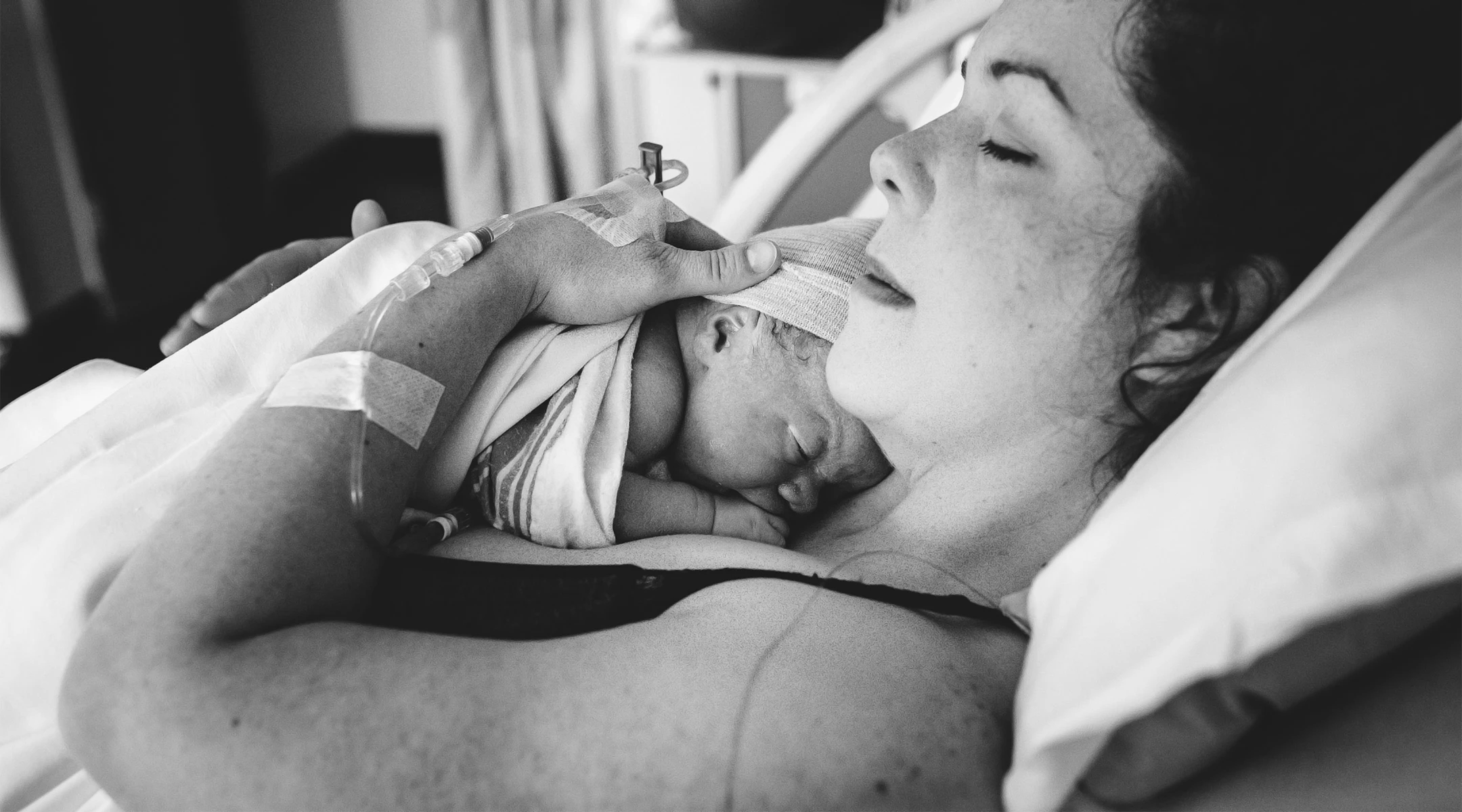Rooming in With Baby Vs Hospital Nursery: the Pros and Cons
Mucus plug. Effacement. Apgar score. With all the unfamiliar terms associated with childbirth and newborn care, it can feel like you’re learning a new language. One term you may have heard during your hospital tour is “rooming in”—meaning having baby with you in your hospital room 24/7 postdelivery. These days, many hospitals are encouraging the practice. But is rooming in with baby the best option for you? Learning what to expect from the rooming in experience, understanding how the hospital newborn nursery works and knowing you have a choice can empower you to make the best decision for you and your family when D(elivery) Day rolls around.
“Rooming in” refers to the practice of keeping baby with you in your hospital room while you recover from childbirth and get to know your newborn. A lot of hospitals across the country—especially those designed “baby-friendly”—are viewing rooming in as the standard of care, given the many purported advantages for Mom and baby. “The benefits of rooming in include skin-to-skin contact, establishing breastfeeding and learning to become more confident in reading baby’s cues,” explains Amanda Gorman, CRNP, CBS, a pediatric nurse practitioner in Baltimore, Maryland, and founder of Nest Collaborative, a virtual breastfeeding support practice.
Rooming-in policies vary across hospitals. Some hospitals recommend baby rooms in with the mother but have on-site nursery care for newborns if moms need a break. Some hospitals may have restrictions on nursery usage—for example, a baby can only be sent to the nursery during set hours—while other hospitals let parents use the nursery whenever, and for as long as they’d like. And at some hospitals, unless there’s a medical need, moms aren’t able to send their babies to the nursery at all.
There’s a reason hospitals are encouraging the practice of rooming in. To help you decide whether it’s right for you, here’s a rundown of some of the major benefits:
• Positive breastfeeding outcomes. A number of studies show that rooming in with your newborn can help with breastfeeding, both immediately after birth and several months down the line. Why? “Not only do newborns need to feed a lot, but they can be slow to feed,” explains Gorman, who adds it’s not uncommon for a feeding session with a newborn to last up to 45 minutes. “When you’re rooming in, you have the time to really figure out what’s working and what’s not when it comes to feeding.” While lactation consultants are available to all new parents, having your newborn in the room with you when the lactation consultant walks by means you can address any feeding problems in real time.
• Time to bond with baby. You not only have more time to have baby by your side, but you have more time to have baby on your chest too. Skin-to-skin contact, aka kangaroo care, is done by placing baby, undressed, onto your bare chest—and it’s been shown to have lots of benefits. It can help regulate baby’s body temperature and heart rate, and promote breastfeeding. It’s also good for Mom: Having your newborn against your skin can reduce feelings of depression and stress and increase feelings of well-being, regardless of whether or not you plan to nurse.
• A confidence boost in your parenting ability. “One of the benefits of having a baby in the room with you is realizing you can soothe your infant, and you can provide for their needs,” Gorman says. “You have the benefit of the support of the nursing staff, but you can also really gain [experience] and ask questions so you feel confident when you leave the hospital.” She adds, “Learning to read your infant’s cues can be incredibly empowering for all parents.”
• The chance to troubleshoot any issues. Having trouble with latching? Want to make sure your swaddling skills are up to snuff? Some moms consider rooming in to be like baby boot camp, where they can get hands-on practice and ask nurses for guidance if they need help. “I had never held a baby before I had my first daughter,” says Jen H., a mom of three in Jersey City, New Jersey. “I remember trying to swaddle my daughter in the middle of the night, and the nurse just laughing at me. She taught me how to do that, and I left with superior swaddle skills. I’m not sure that would have happened if my daughter hadn’t been in the room with me.”
• More sleep. Some proponents of rooming in say having baby right by your side may give you a chance to get a bit more shut-eye. “When your infant is in the nursery, you have to call a nurse, wait for the nurse to bring your baby, then wait for the nurse to bring your infant back to the nursery,” Gorman says. “When your infant is in the room with you, you can pick them up, feed them and then fall back asleep.”
At the end of the day, the hospital wants both Mom and baby to be safe. Even if you don’t have access to a nursery, “it’s important to know you can call a nurse and let them know what you need,” Gorman says. “Rooming in shouldn’t feel like it’s a torture practice, and a nurse can and should know if you’re in pain, are exhausted or otherwise feel like you need support in caring for baby.”
Rooming in after a c-section
Many new parents wonder if they can room in with baby following a c-section. The answer? It depends on the mom’s medical needs and how she feels. Many parents find they can successfully room in after a c-section or complicated birth as long as there are no medical implications (such as sedative drugs) that may make rooming in unsafe. Having a partner available to help with skin-to-skin contact and transferring baby to Mom for feedings and then back to the bassinet can be invaluable post c-section.
While rooming in can be a great option for moms and their newborns, there are some reasons why you might want to take advantage of a nursery option. Here, some of the notable upsides to using the hospital nursery.
• Time to sleep and recover. Giving birth can be an intense experience, and complications such as tearing or an unexpected c-section can make you feel as though you need some baby-free time to recuperate. “It’s the old adage, but it’s true: Put on your oxygen mask before you help others,” says Talya Miron-Shatz, PhD, a social psychologist who studies birth experiences and founding director of the Center for Medical Decision Making at Ono Academic College in Kiryat Ono, Israel.
• A chance to spend one-on-one time with your other kids. Some parents find the nursery invaluable in giving them some time away from their newborn to pay attention to their older children. “It was important that I see my toddler while I was in the hospital, and I wanted to be able to facilitate how he met his sibling,” says Stacy R., a mom of two. “I had his sister in the nursery so I could pay attention to my son, then had the nurse bring my daughter in. It was relaxed and allowed me to divide my attention between both of my kids.”
• Headspace to relax. Some moms of multiple kids say the nursery was a must to help them wrap their heads around the expansion of their family, and what it meant from going from one child to two. “I knew the basics of infant care when I had my second,” says Kristin J., a mom of two. “I knew sleep would be hard to come by when we came home from the hospital, so I really wanted to use that time with my newborn in the nursery to really relax.”
As you’re preparing for childbirth, putting these questions to your doctor or hospital can help you understand the procedures and what choices are available to you and your family.
• Is the nursery an option? Some hospitals have available nurseries on-site, while others reserve the nursery for babies with specific medical needs.
• Can my partner stay in my room overnight? Parenting is a team process, and it can be helpful to have a partner (or a mom, sister or friend) stay with you in the room, to hold baby and help you.
• What happens if I don’t feel well enough to take care of my newborn? Hearing what support would be at your disposal in a worst-case scenario can help give you peace of mind.
• If I send the baby to the nursery, can I still feed on demand? Some hospitals may have set times when they bring baby to you, while others may bring your child whenever you want. Knowing the nursery schedule can help you understand what your day may look like.
• Will I have a private room? Some hospitals have a policy that moms who room in are given private rooms, while others may offer private rooms for an additional cost. Knowing whether you’ll be with another new mom and their baby can give a clearer picture of what the rooming in process might look like for you.
When it comes to rooming in, there is no “right” choice. You know yourself and your needs, and it’s important to advocate for what makes sense for you. “You’re not a bad mother if you feel you need the nursery,” Miron-Shatz says. Writing a birth plan, thinking of “what if” scenarios and making sure your own needs are met can all help you with the decision. “It’s sometimes a smart idea to designate your partner as the one to take care of you, including making sure you’re eating regularly, while you take care of baby,” says Nichole Joy, a doula and childbirth educator in Tampa, Florida. Coming up with these sorts of strategies, talking to other moms who have roomed in or used a nursery, taking a hospital tour and asking questions—no matter how silly they may seem to you—can all help you decide which option to go with.
Published February 2019
Please note: The Bump and the materials and information it contains are not intended to, and do not constitute, medical or other health advice or diagnosis and should not be used as such. You should always consult with a qualified physician or health professional about your specific circumstances.
Plus, more from The Bump:
Navigate forward to interact with the calendar and select a date. Press the question mark key to get the keyboard shortcuts for changing dates.




















































